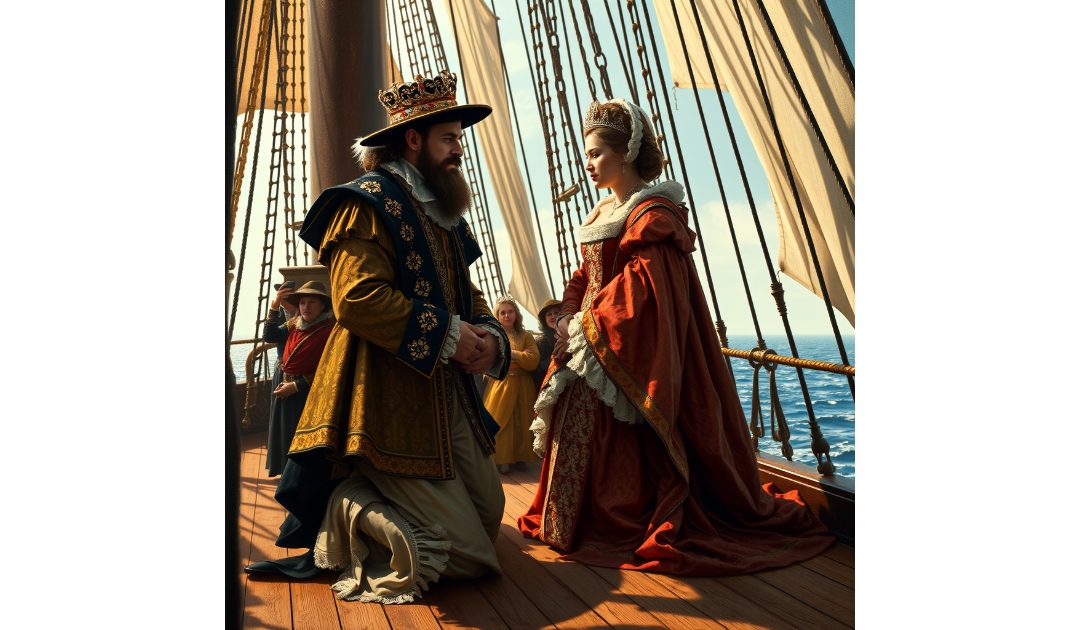On the 4th of April, 1581, Francis Drake was knighted by Queen Elizabeth I following his circumnavigation of the world. Francis Drake, a prominent figure in the late 16th century, was a pivotal character in the maritime history of England, celebrated for his daring exploits and contributions to the expansion of the British Empire.
Born around 1540 in Tavistock, Devon, his early life was steeped in the maritime traditions of the age, setting the stage for his future as a renowned navigator and privateer. Francis Drake was born into a family of modest means. His father, Edmund Drake, was a Protestant farmer who later became a preacher. The family’s Protestant beliefs led to persecution during the Catholic reign of Henry VIII, forcing them to flee to Kent when Francis was only about nine years old. This upheaval and the family’s resilience in the face of adversity likely shaped Drake’s determined and adventurous character.
In Kent, the Drakes lived near the bustling maritime hub of Chatham, providing young Francis with his first exposure to the sea. His father, having secured a position as a lay minister in the Navy, ensured that Francis was well-acquainted with the workings of ships and the life of sailors. This upbringing, amidst the naval activities along the Thames, kindled Drake’s interest in seafaring from a young age.
Drake’s seafaring career began in earnest when he was apprenticed to a freighter’s master, who was a relative of Drake’s. This apprenticeship was pivotal, giving him the opportunity to learn the intricacies of navigation and ship handling. He quickly made a name for himself through his exceptional skill and courage at sea. By his early twenties, Drake was commanding his own ship.
Drake first came into the limelight during the 1560s through his expeditions to the Americas. He initially sailed with his cousin, Sir John Hawkins, on slaving voyages to the Spanish Main, a venture that was both lucrative and fraught with peril. These early voyages sowed the seeds of enmity between Drake and the Spanish, as they often involved engagements with Spanish vessels and ports.
In 1572, Drake embarked on one of his most famous expeditions, the attack on the port of Nombre de Dios in Panama. Although the raid was partially successful, it was during this voyage that he first saw the Pacific Ocean from atop a mountain. He swore to sail an English ship on its waters, a vow he would fulfill in spectacular fashion.
Drake’s most famous voyage began in 1577 when he was commissioned by Queen Elizabeth I to undertake a circumnavigation of the globe. Departing England with a fleet of five ships, Drake encountered numerous challenges, including hostile engagements and treacherous weather. The journey saw the loss of several ships, with Drake’s flagship, the Golden Hind, ultimately carrying on the mission.
Drake’s circumnavigation lasted from 1577 to 1580, and it was marked by significant achievements. He explored the west coast of the Americas, claimed land for England (in what is today California), and ventured into the Spice Islands. His return to England was triumphant, laden with treasures captured from Spanish ships, which significantly strained Anglo-Spanish relations.
The Queen knighted Drake in 1581 aboard the Golden Hind, cementing his status as a national hero and a significant player in the naval prowess of England. His exploits made him a legend in his own time, feared by the Spanish who dubbed him “El Draque”—The Dragon.
Drake’s naval career continued with his involvement in the Anglo-Spanish War. He played a crucial role in the defeat of the Spanish Armada in 1588, where his strategic acumen and maritime experience helped England to thwart Spain’s attempted invasion. Despite a mix of successes and failures in his later campaigns, Drake remained a respected figure.
In his personal life, Drake was married twice, though he left no direct heirs. His wealth and fame allowed him to purchase estates in Devon, where he sometimes retired between his voyages.
Francis Drake’s life ended on a military expedition against Spain in 1596. He succumbed to dysentery while anchored off the coast of Panama. His body was buried at sea in a lead-lined coffin, dressed in his armor, a testament to his enduring legacy as a fearsome mariner.
It was in George Malcolm Thomson’s biography of Francis Drake that I discovered Sir Anthony Standen, the Elizabethan Spy. Since my mother’s maiden name was Standen, I took a great interest. The Oxford Dictionary of National Biography was an excellent source, as was Daphne Du Maurier’s The Golden Lads. I have since discovered that he was elder brother of my 10th great-grandfather, Edmund Standen.

